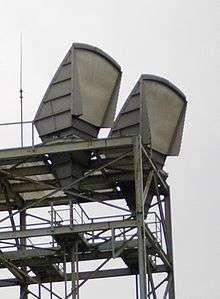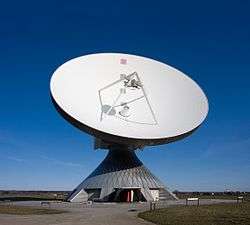Microwave antenna
A typical larger microwave antenna designed for mid to long range

C band horn-reflector antennas on the roof of a telephone switching center in Seattle, Washington, part of the U.S. AT&T Long Lines microwave relay network.
A microwave antenna is a physical transmission device used to broadcast microwave transmissions between two or more locations.
Microwave frequency bands
| C band | 4 to 8 GHz | 3.75 cm to 7.5 cm | 4 GHz, 6 GHz |
| X band | 8 to 12 GHz | 25 mm to 37.5 mm | 10 GHz, 11 GHz |
| Ku band | 12 to 18 GHz | 16.7 mm to 25 mm | 12 GHz, 18 GHz |
| K band | 18 to 26.5 GHz | 11.3 mm to 16.7 mm | 18 GHz |
| Ka band | 26.5 to 40 GHz | 5.0 mm to 11.3 mm | 23 GHz, 31 GHz |
| Q band | 33 to 50 GHz | 6.0 mm to 9.0 mm | 38 GHz |
| W band | 75 to 110 GHz | 2.7 mm to 4.0 mm | 70 GHz, 80 GHz, 90 GHz |
Uses
See also: Microwave transmission
- One-way (e.g. television broadcasting) and two-way telecommunication using communications satellites
- Terrestrial microwave relay links in telecommunications networks including backbone or backhaul carriers in cellular networks linking BTS-BSC and BSC-MSC.
Styles
A parabolic antenna is an antenna that uses a parabolic reflector, a curved surface with the cross-sectional shape of a parabola, to direct the radio waves. These devices range anywhere from 6" to more than 12' diameter depending on application and use.
A horn antenna or microwave horn is an antenna that consists of a flaring metal waveguide shaped like a horn to direct radio waves in a beam. Horns are widely used as antennas at UHF and microwave frequencies, above 300 MHz.[2]
References
- ↑ http://wireless.fcc.gov/services/index.htm?job=service_home&id=microwave
- ↑ Bevilaqua, Peter (2009). "Horn antenna - Intro". Antenna-theory.com website. Retrieved 2010-11-11.
This article is issued from Wikipedia - version of the 10/16/2016. The text is available under the Creative Commons Attribution/Share Alike but additional terms may apply for the media files.
